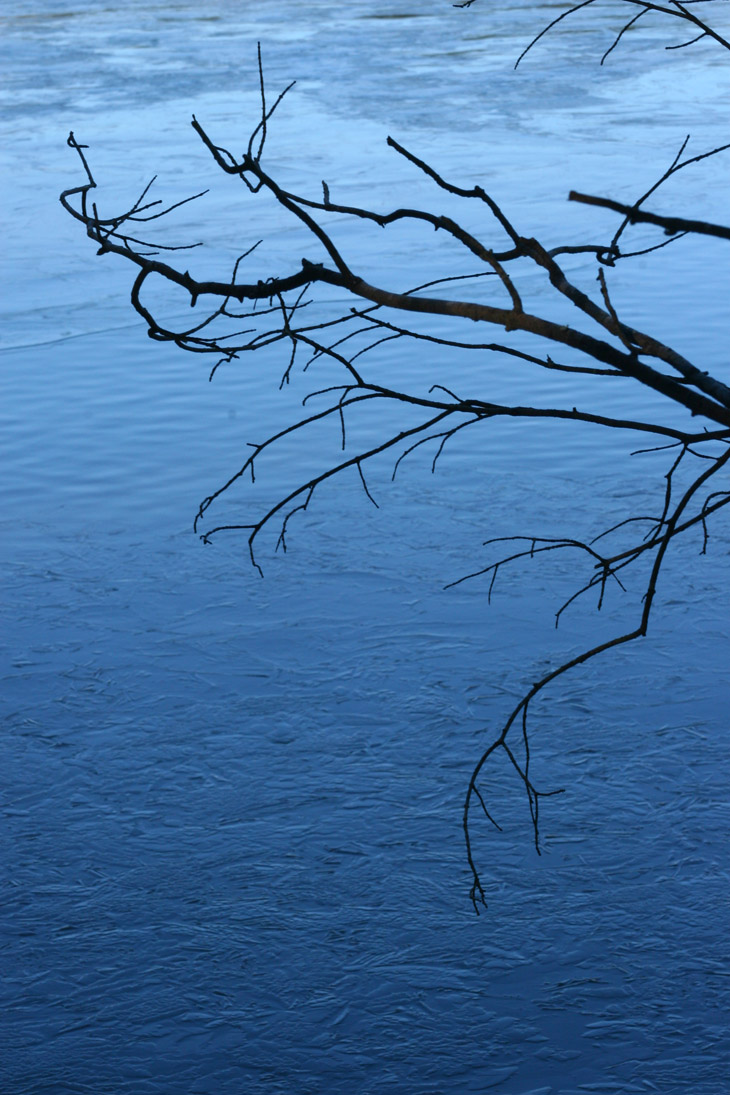
No, I have not started the new year with a turnaround from the thinner posting schedule that I maintained last year, and it presently doesn’t seem likely. But I’ll take whatever opportunity I get to post new content, and (for better or worse) I’ll still be podcasting now and then.
 Moving on to real content rather than excuses, we did not escape the winter weather that hit the east coast, actually getting a pretty decent snow – not as much as threatened or feared, but in the immediate area it was a couple of inches (pardon me for not using metric, but it just sounds better this way.) Alas, I still had commitments, and had to drive in it for each of the worst days, just not very far. But that meant that I didn’t have much opportunity to shoot photos of it – the first day I spent a lot of time clearing off the cars and the driveway, plus it was overcast and not quite finished snowing, and I didn’t bother even trying to go out. So I did a quick look around on the second day when the sun was out, and by then, the neighborhood had been out with their dogs everywhere and the pristine white blanket was all torn up, greatly limiting my options. Above, I took advantage of the sky reflecting from the textured and incomplete ice cover on the pond and started doing the fartsy thing; seen to the right, the just-barely-frozen surface in another section of the same pond yielded some unusual patterns.
Moving on to real content rather than excuses, we did not escape the winter weather that hit the east coast, actually getting a pretty decent snow – not as much as threatened or feared, but in the immediate area it was a couple of inches (pardon me for not using metric, but it just sounds better this way.) Alas, I still had commitments, and had to drive in it for each of the worst days, just not very far. But that meant that I didn’t have much opportunity to shoot photos of it – the first day I spent a lot of time clearing off the cars and the driveway, plus it was overcast and not quite finished snowing, and I didn’t bother even trying to go out. So I did a quick look around on the second day when the sun was out, and by then, the neighborhood had been out with their dogs everywhere and the pristine white blanket was all torn up, greatly limiting my options. Above, I took advantage of the sky reflecting from the textured and incomplete ice cover on the pond and started doing the fartsy thing; seen to the right, the just-barely-frozen surface in another section of the same pond yielded some unusual patterns.
Snow cover can be very informative about just what kind of wildlife is visiting the area, at least if you’re halfway decent at reading tracks. I can identify most of the common visitors, but I still get stumped occasionally. I know, I know, it’s a deplorable state of affairs, hardly what you should expect from someone of my extensive educational background; you’re welcome to contact Nonexistent Polytechnic and ask them to revoke my Super Doctorate…
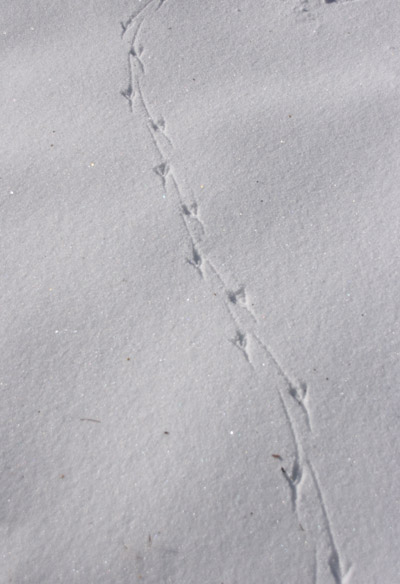 Initially, I thought I knew what made these, but now I’m not exactly sure. The mark from the prominent “thumb” toe (hallux) indicated, to me, a woodpecker of some sort, supported by the size of the tracks, about 35-40mm overall; the woodpeckers have larger-than-average halluces for bracing against trees as they drill for food. But two things made me pause a little. The first is the left-right alternating steps, which doesn’t seem correct to me, but I admit I’ve only seen them scaling trees and not foraging on the ground. Most of the birds in this area hop, keeping both feet together, and the only one I can recall seeing walk left-and-right are crows, but these tracks were too small for them. The second detail is the drag marks between. Again, I thought this was from the hallux, but as I looked at the photos I realized it was from the third phalange, the middle toe, skimming the snow. So at present, I’m not going to positively identify the creator of these tracks.
Initially, I thought I knew what made these, but now I’m not exactly sure. The mark from the prominent “thumb” toe (hallux) indicated, to me, a woodpecker of some sort, supported by the size of the tracks, about 35-40mm overall; the woodpeckers have larger-than-average halluces for bracing against trees as they drill for food. But two things made me pause a little. The first is the left-right alternating steps, which doesn’t seem correct to me, but I admit I’ve only seen them scaling trees and not foraging on the ground. Most of the birds in this area hop, keeping both feet together, and the only one I can recall seeing walk left-and-right are crows, but these tracks were too small for them. The second detail is the drag marks between. Again, I thought this was from the hallux, but as I looked at the photos I realized it was from the third phalange, the middle toe, skimming the snow. So at present, I’m not going to positively identify the creator of these tracks.
[You know where I said above about all the snow being torn up? This is a very small section that I chose for clarity, and you can even see the faintest hint at the top of the frame where I cropped out the human and dog tracks – it really was hard to find a decent expanse of untouched snow…]
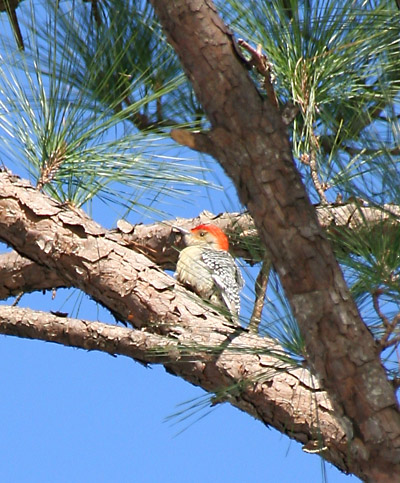 Soon after spotting the tracks, I also caught a red-bellied woodpecker (Melanerpes carolinus) zooming from down low up to a safer tree branch, seeming to confirm my identification. And it still might, but there remains a couple of points to note, such as not being the only bird visible in the area by far, and the snow having gone through an overnight refreeze by the time I was out shooting, turning the surface into a hard crust that was far too tough for a medium-sized bird to leave distinctive tracks; this trail was from the previous day. However, in an area of our yard where The Girlfriend had tossed out some beef and bacon grease, I found an extensive cluster of the same tracks, and woodpeckers are very fond of grease, so make of that what you will.
Soon after spotting the tracks, I also caught a red-bellied woodpecker (Melanerpes carolinus) zooming from down low up to a safer tree branch, seeming to confirm my identification. And it still might, but there remains a couple of points to note, such as not being the only bird visible in the area by far, and the snow having gone through an overnight refreeze by the time I was out shooting, turning the surface into a hard crust that was far too tough for a medium-sized bird to leave distinctive tracks; this trail was from the previous day. However, in an area of our yard where The Girlfriend had tossed out some beef and bacon grease, I found an extensive cluster of the same tracks, and woodpeckers are very fond of grease, so make of that what you will.
Or you can correct my ornithological shortcomings, right out here in public, because we’re past the christmas season and there’s no need to be on good behavior any more. Like, you know, everybody was being so cheerful and selfless before the holidays rolled around…
Mr Bugg, who’s lagging far behind in both post and photo count, decided to be snarky when he finally put an update in a few days back, which just meant that I didn’t bother telling him when I was heading out this morning. Well, that, and the fact that the fog conditions that I was after, courtesy of the warm front that’s rapidly melting the snow, would clear very fast and I had no time to waste at all if I wanted to get something decent.
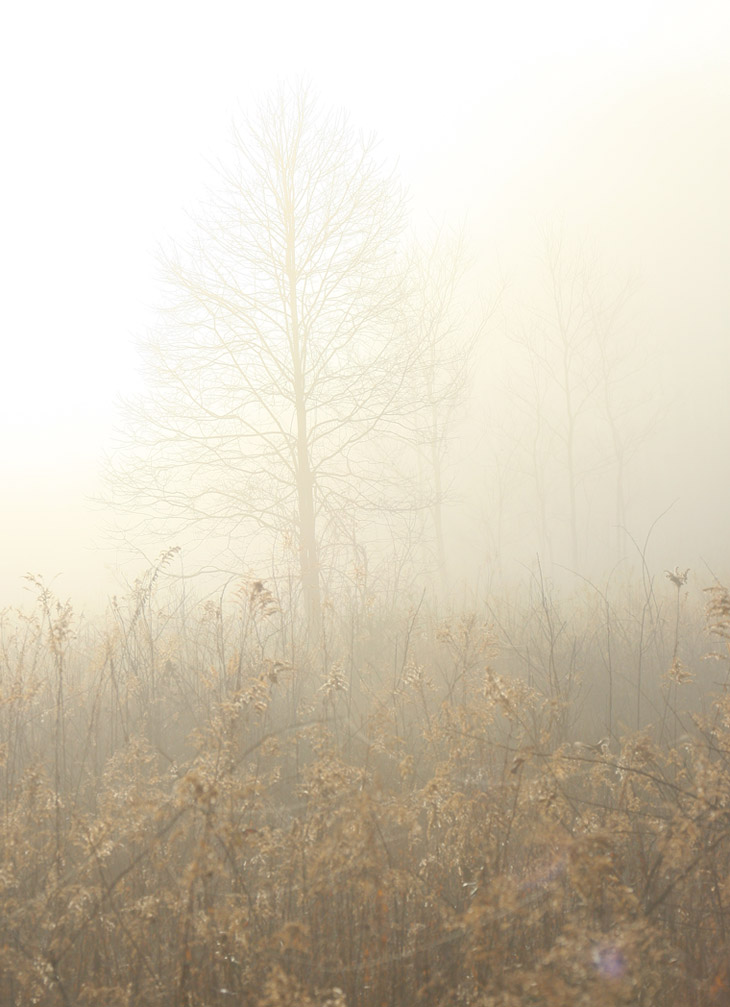
There aren’t a lot of options in the immediate area for fog settings, and I was running later than I should have for optimum conditions, so I simply hit Mason Farm Biological Reserve a few kilometers away. The sun was already rising above the thick fog banks and the snow cover was patchy, so I picked the layouts that I could to make the most of it. I should have been out the previous evening when the fog rolled in under a full moon that occasionally peeked out, but by the time I got free I was tired and not really motivated to go out looking for abandoned barns or old cemeteries, the kind of subjects that work well in those conditions; I still haven’t pinned down a couple of go-tos for fog like I should’ve. Ah well, I’m still pleased with what I did get.
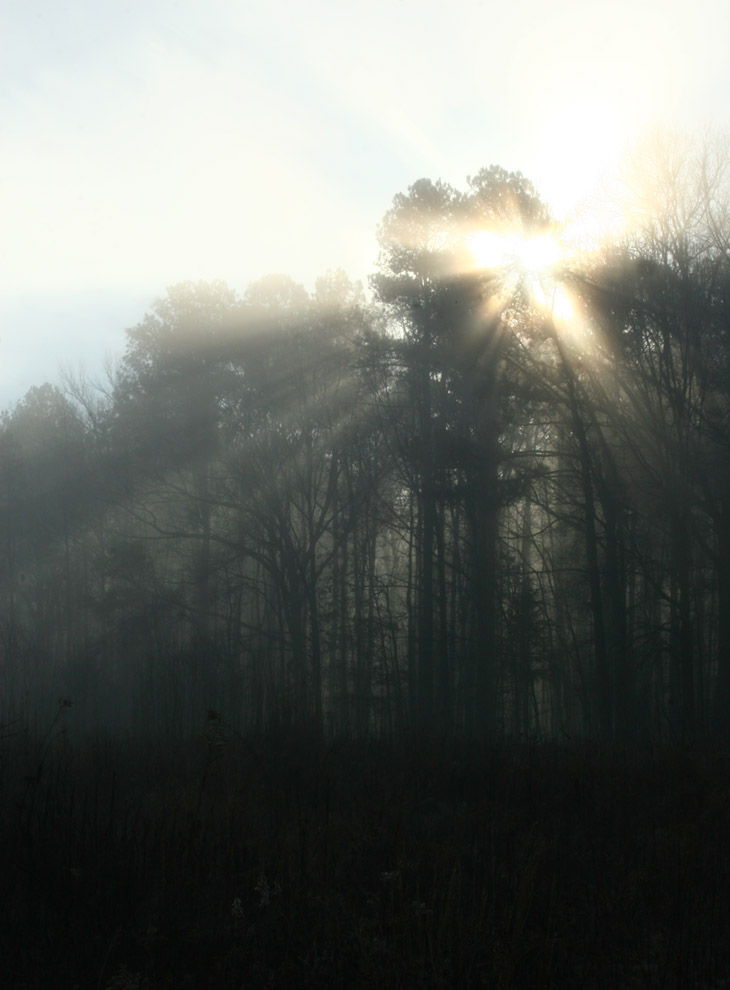
Longneedle pines are not the best trees to use for blocking direct sunlight, but whatcha gonna do? By this point the light was getting far too bright to have coming directly into the lens, and the opposite direction wasn’t producing any nice landscapes.
Spiders (oh, shit, yes, we’re back to spiders) are surprisingly weather-hardy, and there were still a few patches and strands of spiderwebs to be found here and there. Coupled with the heavy humidity and backlighting, just like a previous visit, they provided a little something to work with.
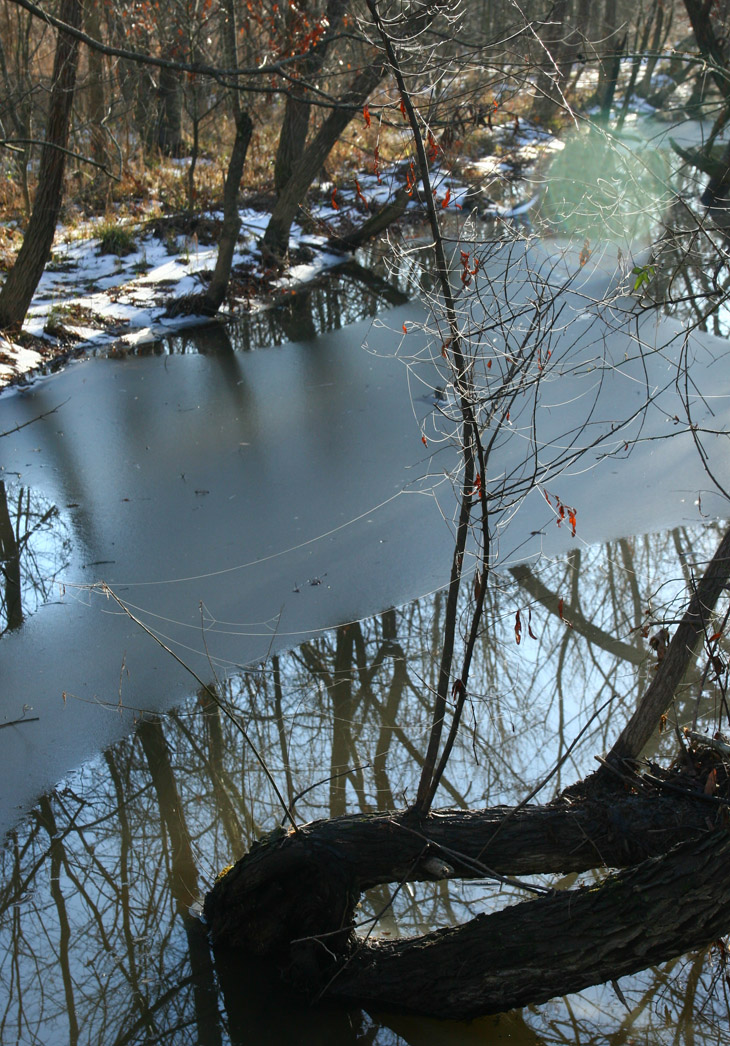
At the best of times, the low winter sun can get in the shots, but sunrise doesn’t help at all – I couldn’t avoid the green ghost lens flare. Well, I could, and did – another shot has my hand visible at the top of the frame, blocking the light, and the autofocus wandered off the webs and onto the background, rendering the photo unusable, so we’ll cope with the ghost (won’t we?) It’s just a shot to show the webs against the winter conditions anyway, and that patch of ice is probably gone now. But of course I went in closer on a nice dew display – it’s not a photo outing for me unless I get the macro lens out.
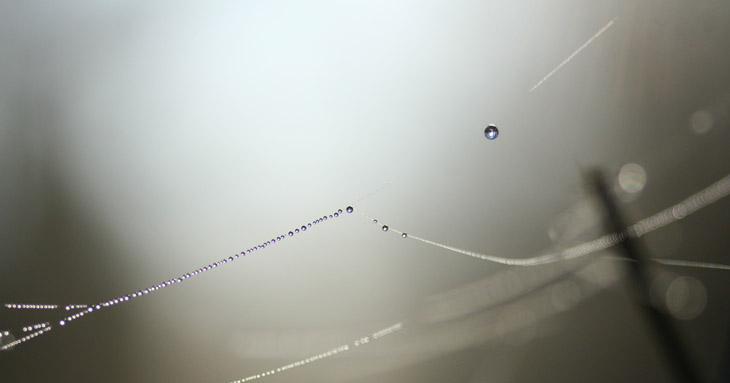
There were some very fine droplets flanking that big one, up until I inadvertently bumped the plant, but this served to isolate the drop in space, so happy accidents, eh? In this light, the web could appear and disappear with very slight changes in position, and I purposefully chose this one to levitate the prominent drop. You can’t quite see that it’s showing a view of the landscape behind it, and this could have made a neat shot had I gone in closer, but I doubt I could have held still enough to get it sharp, and the tripod wasn’t an option for this particular subject, so here we are. If I hadn’t told you that it might have been better, you would have been perfectly happy with it – I should learn to keep my mouth shut. Or my fingers still. Whatever.




















































